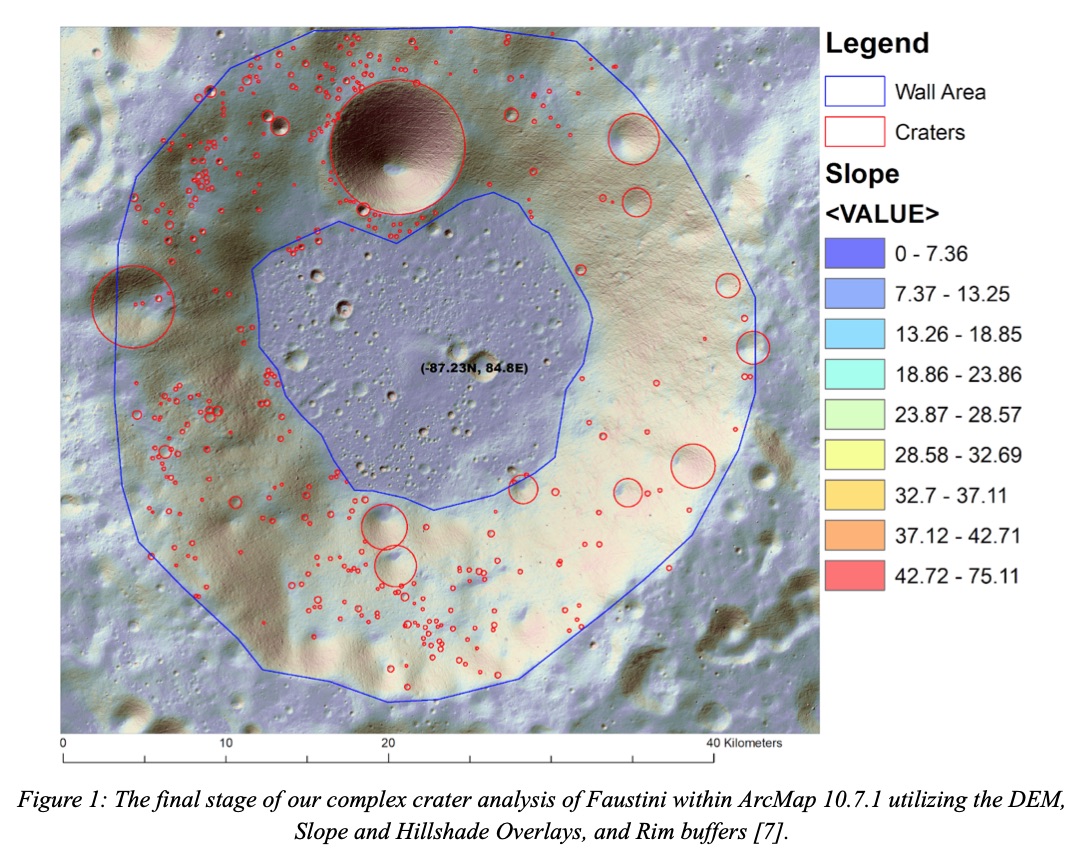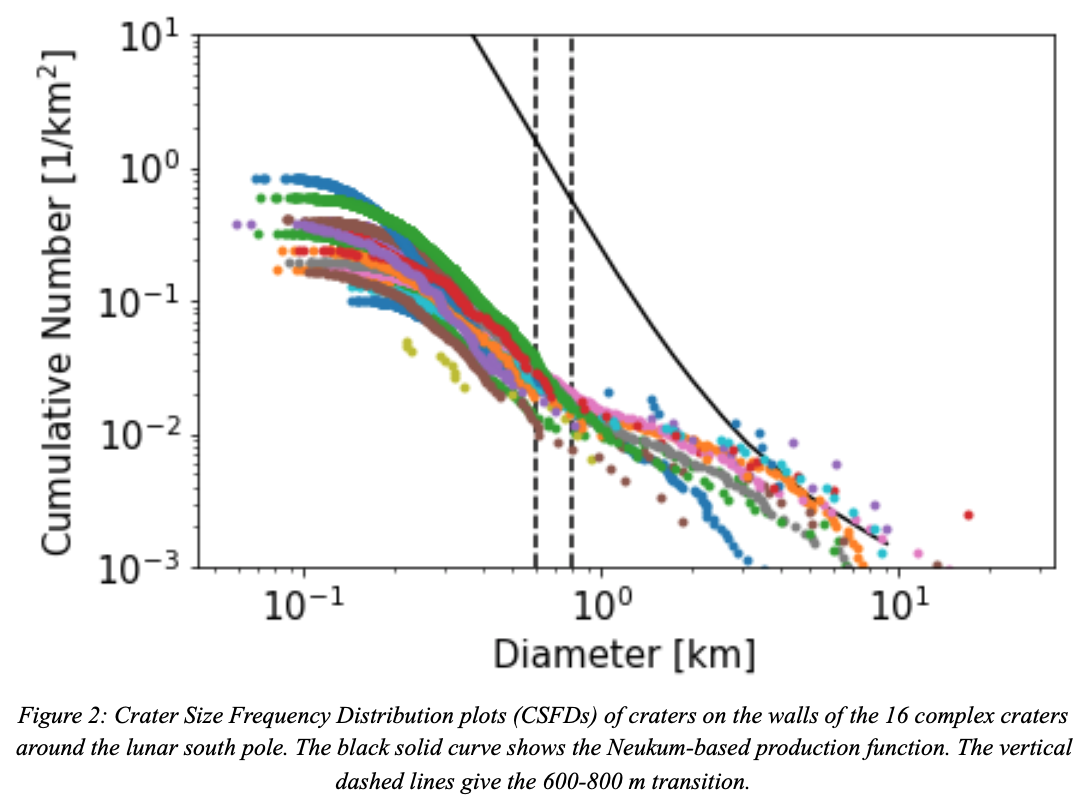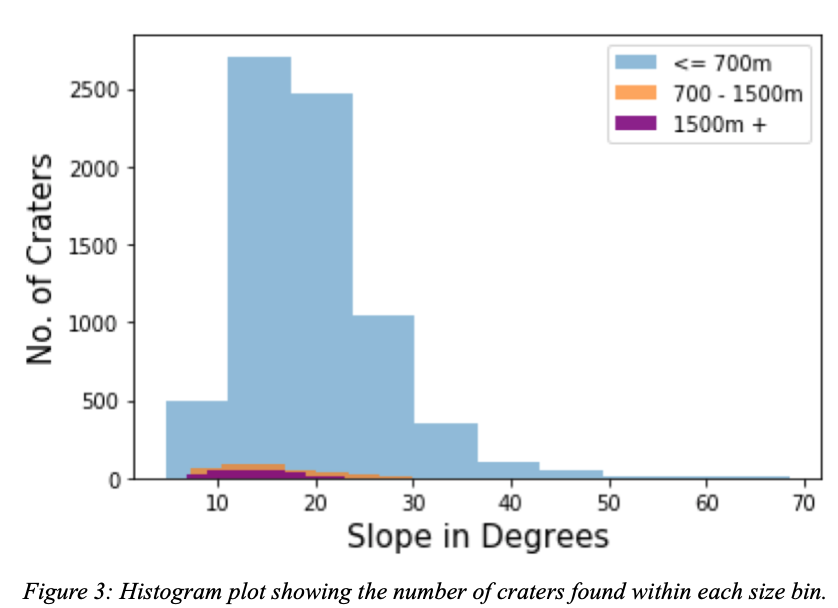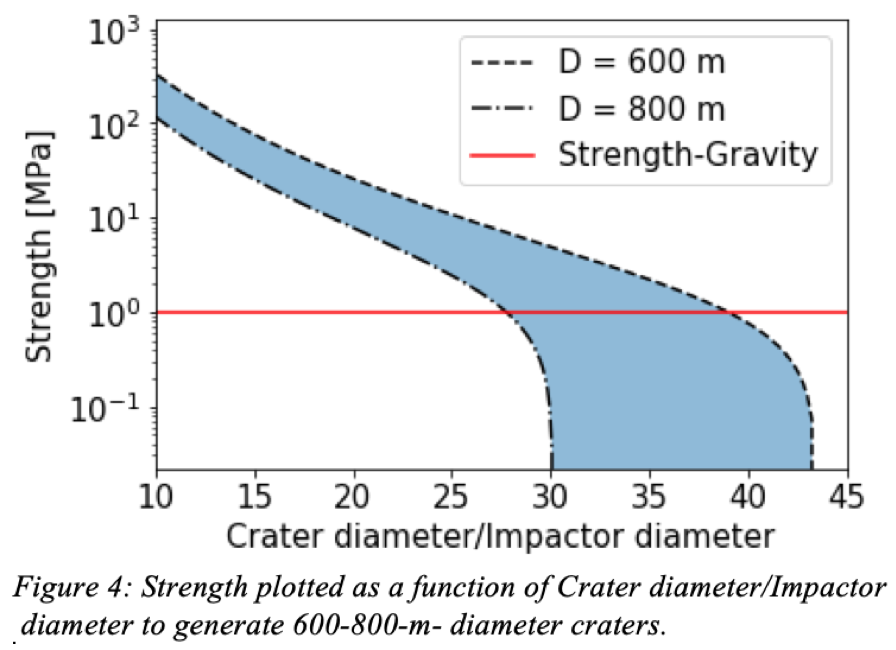The absence of crater populations larger than 600-800 m in diameter on the walls of lunar complex craters
- Department of Geosciences, Auburn University, Auburn, AL, United States of America (clt0040@auburn.edu)
Introduction: Repeated impact events on the Moon are the main drivers of the degradation of the lunar surface. This process, known as topographic diffusion, is the scattering of the regolith which causes the eventual erasure of impact craters due to overlapping and adjacent impactors [1-6]. Visual results of this can be observed by looking at different rates of degradation among lunar south pole complex craters.
Complex craters exhibit landslide morphologies on their walls over a range of sizes. These events are directly linked to the process of topographic diffusion. Within our study, we analyze 16 complex crater morphologies and degradation states to determine the relative wall strength. We find that there is a crater diameter population transition at 600-800 m with larger populations showing significant reduction. We attribute this finding to the induction of landslide events from larger impactors, while smaller impactors do not have enough energy to do so.
Methods: We first utilize ArcMap 10.7.1 and the CraterTools [7] add in toolset to crater count on the walls of the complex craters. We use available DEM’s from LOLA/LRO data, Hillshade and Slope overlays, Buffer (Analysis) Tool, and Add Surface Information (3D Analyst) Tool. The Hillshade and Slope overlays grant us visibility of the lunar surface down to a 20m/pixel resolution in an otherwise partially permanently shadowed area [8]. For each crater count, we determine the slope conditions for the emplacement by creating a 1-pixel buffer around the rim and calculating the average slope of each overlapping pixel based off of our Slope overlay (Figure 1).

We next apply the π scaling impact-crater scaling relationship, which allows us to relate energy, crater size and material strength (Equation 1) [2].
(1)
where V represents the transient crater volume, mi, ρi, and ai represent the impactor’s mass, density and radius, ρt is the target density, g is the gravity, vi is the impact speed, and μ, K1 and Y are experimentally derived constants of the target material. By relating all of these, we compute the impactor diameter, speed, and bulk density [2].
Results: We created a cumulative size frequency distribution (CSFD) plot (Figure 2) of all of the crater counts across the 16 complex craters and found two distinct slope transitions shown in Figure 2. The results show that the slope power of craters larger than 600-800 m in diameter is much shallower (around -1) than that of the Neukum crater production function (around -3).

By analyzing crater size distributions in relation to the wall’s slope, we find that the major crater size range is < 700 m. We counted 7251 craters smaller than 700 m in diameter, while the 700-1500 m diameter range has 362, and >1500 m has only 289. This trend can be seen in Figure 3 and exhibits the location dependence on the slope, where smaller craters can be located at higher surface slopes, while larger craters are located at lower surface slopes.

We finally analyze how the crater diameter/impactor diameter ratio depends on the strength when 600-800 m diameter craters induce mass flows that can erase them. Figure 4 exhibits the target strength as a function of the crater size/impactor size ratio, later known as the f ratio. The enclosed region illustrates the strength needed to create crater diameters ~ 600 – 800 m. This area was derived by assuming the impactor speed to be 15 km/sec [9], and the target and impactor densities to be identical. The f ratio ranges to 30~45 within the gravity regime. The red line in the figure denotes the 1 MPa line, indicating the transition between the strength and gravity regimes. If the strength is less than 1 MPa, the crater formation is within the gravity regime. The final morphology and characteristics are driven by gravity. If the strength is greater than 1 MPa, the crater formation is within the strength regime, and the final morphology of the crater is impacted by the strength of the target surface.

Discussions: We hypothesize that craters larger than 600 – 800 m in diameters experienced landslides and were filled with flowed materials. If this is the case, the surrounding walls should fail structurally. The absence of crater diameters > 600 – 800 m implies landslide events with a thickness of ~180 – 240 m (the transient crater diameters of the craters 600 - 800 m in diameter). The necessary (shear) strength that inhibits this event can be derived from ρghsinθ where ρ = 3000 kg/m3, g is the gravity of the Moon, h is the height at 140-240 m and θ is the slope angle at 30°, which is an upper threshold of the existence of craters larger than 600 – 800 m in diameter, giving a necessary strength of ~0.5-0.7 MPa. Comparing this with Figure 4 leads to the gravity regime of impact processes, implying that the walls are structurally weakened due to the emplacement of the host crater and subsequent smaller impacts. This weakening process likely changes the f ratio, meaning that the surface material property changes the impactor/crater relationship overtime, giving a caution to examine the crater size [10].
Acknowledgements: CLT thanks the Department of Geosciences at Auburn University for their support. Part of this research was completed using LOLA data from the PDS Geosciences Node at WUSTL.
References: [1] Gault (1970), Radio Science 5, 273-291, [2] Richardson (2009), Icarus 204, 172-190, [3] Fassett and Thomson (2014), J. Geophys. Res. Planets, 119, 2255-2271, [4] Minton (2015), Icarus 247, 172-190, [5] Hirabayashi (2017), Icarus 289, 63-87, [6] Minton et al. (2019), Icarus 289, 134-143, [7] Kneissl et al., (2011), [8] Riris et al., (2010), ICSO, [9] Johnson et al., (2016), Icarus 271, 350-259, [10] Holsapple (1993), Annu. Rev. Earth Planet. Sci. 21, 333-337.
How to cite: Talkington, C. L., Hirabayashi, M., Montalvo, P., and King Jr., D.: The absence of crater populations larger than 600-800 m in diameter on the walls of lunar complex craters, European Planetary Science Congress 2021, online, 13–24 Sep 2021, EPSC2021-321, https://doi.org/10.5194/epsc2021-321, 2021.

